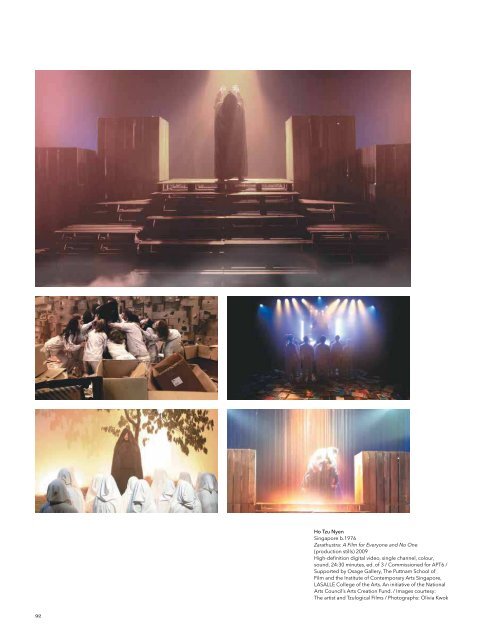Queensland Art Gallery - Queensland Government
Queensland Art Gallery - Queensland Government
Queensland Art Gallery - Queensland Government
You also want an ePaper? Increase the reach of your titles
YUMPU automatically turns print PDFs into web optimized ePapers that Google loves.
Ho Tzu Nyen<br />
Of the way of the creator<br />
Friedrich Nietzsche’s best known work, Also Sprach Zarathustra: Ein<br />
Buch für Alle und Keine (Thus Spoke Zarathustra: A Book for Everyone<br />
and No One) (1883–85), is a stirring metaphorical treatise on many of<br />
the German philosopher’s key ideas. These include the potential of<br />
humanity to transcend its circumstances, embodied in the figure of the<br />
übermensch, or overman; and a rejection of the metaphysical world,<br />
summarised in the famous phrase ‘God is dead’. Written in a neo-Biblical<br />
style (paradoxical given Nietzsche’s criticism of Christianity), the book<br />
features as its central character the ancient Persian prophet Zarathustra,<br />
who descends from a mountain to teach his ideas of the overman to a<br />
modern world without God, its people lost in a nihilistic wasteland. 1<br />
Ho Tzu Nyen’s Zarathustra: A Film for Everyone and No One 2009 is<br />
a condensed representation of Nietzsche’s narrative, presented as<br />
a starkly staged video and sound piece. Produced in collaboration<br />
with students from the film, fine arts, music, acting and musical<br />
theatre departments at Singapore’s LASALLE College of the <strong>Art</strong>s, the<br />
work weaves the pedagogical impulse of Nietzsche’s text — in which<br />
Zarathustra brings his knowledge to the masses, and then leaves<br />
them to find their own way — into its method of production. With his<br />
philosophy of overcoming the self and building the new, Nietzsche<br />
foregrounds creativity and, by making the film within an art school, Ho’s<br />
work reflects on the creative act and the process of becoming an artist.<br />
As with many of Ho’s previous works — such as the painting and video<br />
installation Utama: Every Name in History is I 2003, the video work<br />
The Bohemian Rhapsody Project 2006 and the theatre production The<br />
King Lear Project 2008 — Zarathustra reworks existing cultural icons.<br />
The soundtrack for Zarathustra features another work inspired by<br />
Nietzsche’s book, Richard Strauss’s 1896 tone poem of the same name,<br />
which has one of most famous opening sequences in music — in part<br />
due to its use in Stanley Kubrick’s 1968 film 2001: A Space Odyssey. 2<br />
In his ambitious adaptations of historical works, Ho also pulls apart<br />
the medium he is using, be it painting, film, video or theatre. Drawing<br />
attention to constituent elements such as sound, image, editing and<br />
staging, he lays bare conventions and processes, as well as making<br />
connections to other histories and art forms.<br />
the mechanics of the video’s production in full view. The narrative of<br />
Nietzsche’s book may be unfamiliar to some, but Strauss’s music is<br />
immediately recognisable, most likely associated with Kubrick’s aligning<br />
planets. In a sense, Ho’s work returns it to its original inspiration — the<br />
rising of the sun, and the descent of Zarathustra from the mountain.<br />
Complex and self-reflexive, Ho Tzu Nyen’s works are driven by a<br />
palpable passion for his material and a strong sense of humour. While<br />
iconic, many of his source texts are somewhat flawed: unfinished,<br />
overreaching, or incomprehensible. Nietzsche’s book is all three —<br />
Harold Bloom refers to it as a ‘gorgeous disaster’ 4 — and its excesses<br />
reflect the philosopher’s fragile constitution and intensity of feeling.<br />
As translator RJ Hollingdale wrote:<br />
. . . unlike most people, even most philosophers, Nietzsche lived<br />
with his intellectual problems as with realities, he experienced a<br />
similar emotional commitment to them as other men experience<br />
to their wife and children. 5<br />
Ideas, after all, are what make us human, and creativity propels us<br />
forward — but no-one said it was going to be easy.<br />
Russell Storer<br />
Endnotes<br />
1 Zarathustra (or Zoroaster) was a Persian prophet and poet living around 1200–1500<br />
BCE. Following a divine vision, he rejected the polytheistic religion of his people<br />
and preached belief in one creator God, founding Zoroastrianism, one of the<br />
world’s earliest monotheistic faiths. Its followers today are largely in India (known<br />
as Parsis) and Iran.<br />
2 Alex Ross, The Rest is Noise: Listening to the Twentieth Century, Harper Perennial,<br />
London, 2009, p.7.<br />
3 See Harold Bloom, The Anxiety of Influence: A Theory of Poetry, Oxford University<br />
Press, New York, 1973.<br />
4 Harold Bloom, The Western Canon: The Books and School of the Ages, Macmillan,<br />
London, 1995, p.210.<br />
5 RJ Hollingdale, ‘Introduction’, in Friedrich Nietzsche, Thus Spoke Zarathustra: A<br />
Book for Everyone and No One, trans. RJ Hollingdale, Penguin Classics, London,<br />
2003, p.11.<br />
Ho Tzu Nyen<br />
Singapore b.1976<br />
Zarathustra: A Film for Everyone and No One<br />
(production stills) 2009<br />
High-definition digital video, single channel, colour,<br />
sound, 24:30 minutes, ed. of 3 / Commissioned for APT6 /<br />
Supported by Osage <strong>Gallery</strong>, The Puttnam School of<br />
Film and the Institute of Contemporary <strong>Art</strong>s Singapore,<br />
LASALLE College of the <strong>Art</strong>s. An initiative of the National<br />
<strong>Art</strong>s Council’s <strong>Art</strong>s Creation Fund. / Images courtesy:<br />
The artist and Tzulogical Films / Photographs: Olivia Kwok<br />
An ongoing interest of Ho’s, influenced by the literary critic Harold<br />
Bloom, is the idea of ‘misprision’, in which young artists find their<br />
voice by creatively misreading the works of past masters, which in<br />
turn are re-read in the light of the new. 3 His use of well-known sources<br />
also draws on the audience’s existing images of them, who inevitably<br />
bring these to bear on their viewing of his works. He calls this process<br />
‘mental karaoke’, and as his deconstructed projects unfold, they move<br />
between familiarity, which assumes coherence and understanding,<br />
and a more destabilising fragmentation. Ho’s version of ‘Bohemian<br />
Rhapsody’, for example, uses the lyrics of the British rock band Queen’s<br />
song to construct a courtroom drama, with alternating lead actors and<br />
92 93
















